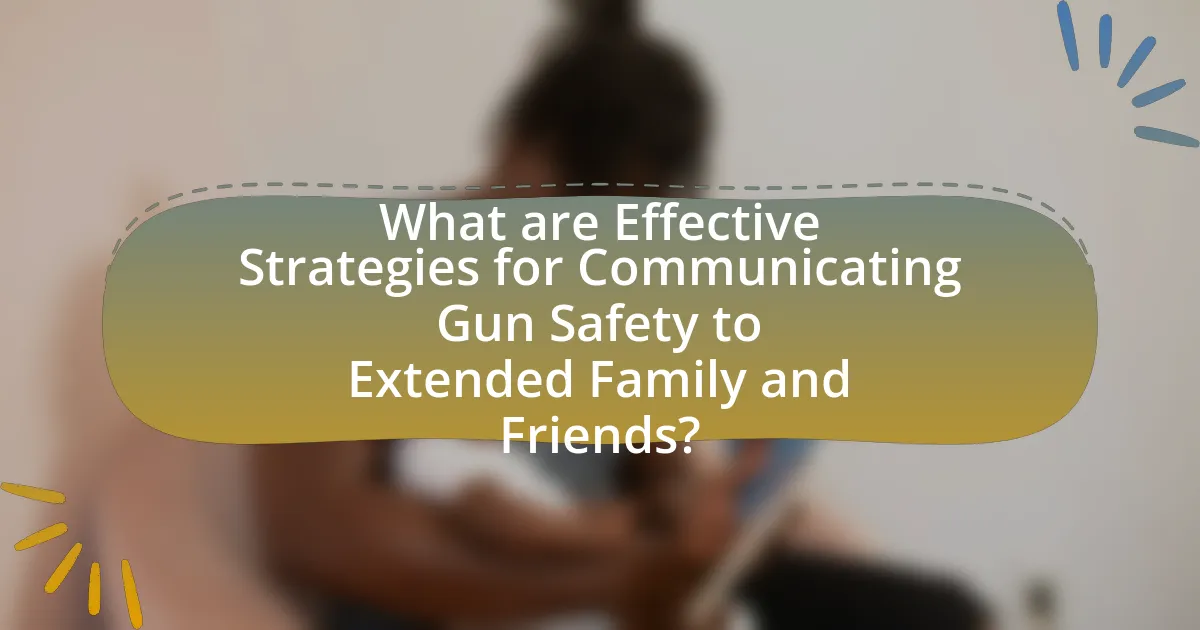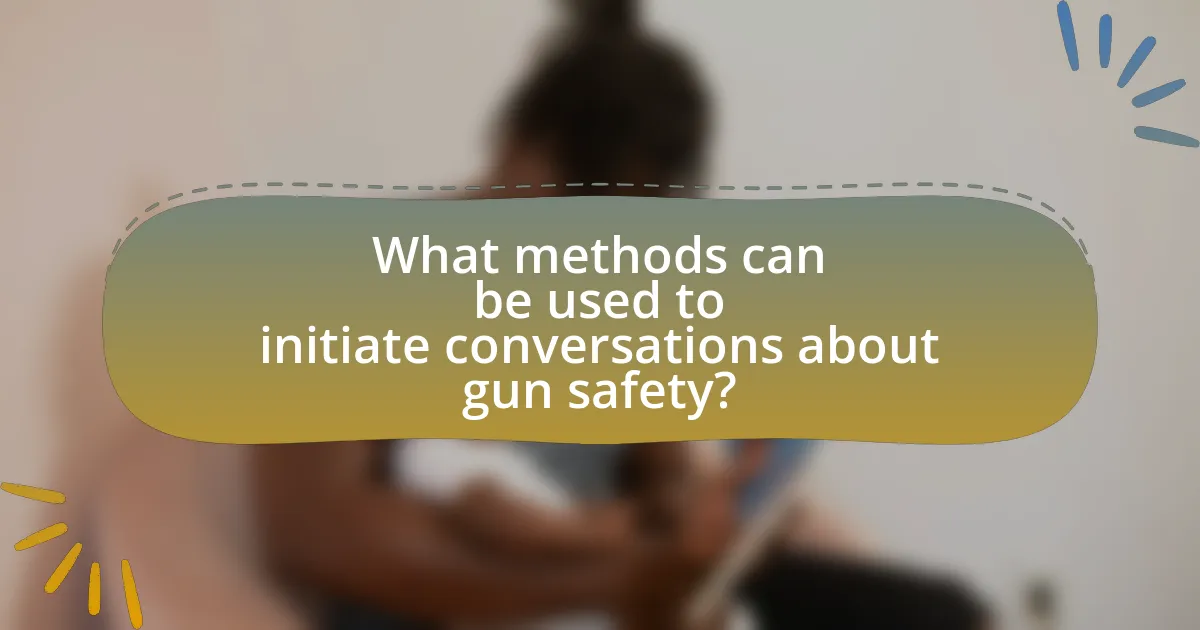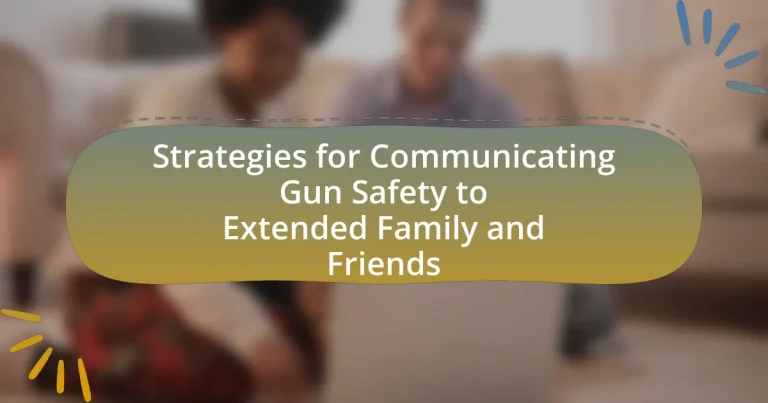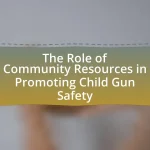The article focuses on effective strategies for communicating gun safety to extended family and friends, emphasizing the importance of open discussions, educational resources, and clear guidelines. It highlights the necessity of proactive communication to prevent accidents and promote responsible firearm handling, particularly in households with children. Key messages include secure storage practices, responsible handling, and awareness of surroundings, supported by research indicating that such discussions significantly reduce risks associated with firearms. The article also explores the role of personal experiences, various communication styles, and the importance of understanding the audience to enhance the effectiveness of gun safety messaging.

What are Effective Strategies for Communicating Gun Safety to Extended Family and Friends?
Effective strategies for communicating gun safety to extended family and friends include open discussions, educational resources, and establishing clear guidelines. Open discussions create a safe space for sharing concerns and experiences related to gun safety, fostering understanding and trust. Utilizing educational resources, such as brochures or videos from reputable organizations like the National Rifle Association or the American Academy of Pediatrics, provides factual information that can help clarify misconceptions about gun safety. Establishing clear guidelines, such as safe storage practices and rules for handling firearms around children, reinforces the importance of safety and responsibility. These strategies are supported by research indicating that proactive communication about gun safety significantly reduces the risk of accidents and promotes a culture of safety within families and communities.
Why is it important to discuss gun safety with family and friends?
Discussing gun safety with family and friends is crucial to prevent accidents and ensure responsible firearm handling. Open conversations about gun safety can lead to increased awareness of safe practices, such as proper storage and handling techniques, which are essential in reducing the risk of unintentional shootings. According to the Centers for Disease Control and Prevention, nearly 500 children die each year from unintentional firearm injuries in the United States, highlighting the need for proactive discussions. By sharing knowledge and establishing safety protocols within personal networks, individuals can foster a culture of safety that protects both loved ones and the community.
What are the potential risks of not communicating gun safety?
The potential risks of not communicating gun safety include increased accidental shootings, unauthorized access to firearms, and a lack of preparedness in emergency situations. Without clear communication about safe handling and storage practices, individuals, especially children, may inadvertently handle firearms improperly, leading to tragic accidents. Research indicates that homes with unsecured guns are significantly more likely to experience gun-related incidents; for instance, a study published in the journal “Pediatrics” found that children living in homes with unlocked firearms are three times more likely to be involved in unintentional shootings. Additionally, failing to discuss gun safety can result in individuals being unprepared for emergencies, such as how to respond if a firearm is encountered unexpectedly.
How can open discussions promote a culture of safety?
Open discussions promote a culture of safety by fostering transparency and trust among individuals. When people engage in open dialogues about safety concerns, they are more likely to share their experiences and insights, which can lead to a better understanding of potential risks. Research indicates that environments where open communication is encouraged result in a 30% reduction in safety incidents, as individuals feel empowered to voice concerns without fear of retribution. This proactive approach not only enhances awareness but also encourages collective responsibility for safety, ultimately leading to more effective safety practices.
What key messages should be included in gun safety communication?
Key messages in gun safety communication should emphasize the importance of secure storage, responsible handling, and awareness of surroundings. Secure storage prevents unauthorized access, particularly by children, as studies show that 73% of children who live in homes with firearms know where the guns are stored. Responsible handling includes treating every firearm as if it is loaded and never pointing it at anything one does not intend to shoot, which is a fundamental safety principle endorsed by the National Rifle Association. Awareness of surroundings involves understanding the environment and potential risks when handling firearms, as situational awareness can significantly reduce accidents. These messages are critical for fostering a culture of safety and responsibility around firearms.
What are the fundamental principles of gun safety?
The fundamental principles of gun safety are to always treat every firearm as if it is loaded, keep the muzzle pointed in a safe direction, keep your finger off the trigger until ready to shoot, and be aware of your target and what is beyond it. Treating every firearm as loaded prevents accidental discharges; pointing the muzzle in a safe direction minimizes the risk of injury; keeping fingers off the trigger until ready to shoot avoids unintentional firing; and being aware of the target and surroundings ensures that no harm comes to unintended individuals or objects. These principles are widely endorsed by organizations such as the National Rifle Association and the National Shooting Sports Foundation, which emphasize their importance in preventing firearm-related accidents and injuries.
How can personal experiences enhance the message of gun safety?
Personal experiences can significantly enhance the message of gun safety by providing relatable and impactful narratives that resonate with individuals. When people share their own encounters with firearms, whether positive or negative, it creates a personal connection that can evoke empathy and understanding. For instance, a study by the American Psychological Association found that storytelling can increase the likelihood of behavior change, as individuals are more likely to remember and be influenced by personal stories than abstract statistics. This emotional engagement can lead to a deeper appreciation for the importance of gun safety practices, making the message more memorable and actionable.
How can different communication styles affect the message?
Different communication styles can significantly affect the message by altering how information is perceived and understood. For instance, a direct communication style may convey urgency and clarity, making the message about gun safety more impactful, while an indirect style might lead to ambiguity and misinterpretation, potentially downplaying the importance of the topic. Research indicates that individuals with a more analytical communication style may focus on data and statistics, which can enhance the credibility of the message, whereas those with an emotional style may prioritize personal stories, fostering empathy but possibly lacking in factual support. This variance in communication styles can lead to different interpretations of the same message, influencing the effectiveness of conveying critical information about gun safety.
What are the various communication styles to consider?
The various communication styles to consider include assertive, passive, aggressive, and passive-aggressive styles. Assertive communication is characterized by expressing thoughts and feelings openly while respecting others, which is crucial for discussing sensitive topics like gun safety. Passive communication involves avoiding confrontation and not expressing one’s needs, potentially leading to misunderstandings about safety practices. Aggressive communication can create conflict and defensiveness, making it ineffective for discussing safety concerns. Passive-aggressive communication combines indirect resistance with avoidance, which can confuse the message about gun safety. Understanding these styles helps tailor conversations to ensure clarity and effectiveness in communicating important safety information.
How can understanding your audience improve the effectiveness of the message?
Understanding your audience enhances message effectiveness by allowing the communicator to tailor content to the specific values, beliefs, and concerns of that audience. When the message aligns with the audience’s perspectives, it increases engagement and receptivity. For instance, research by the Pew Research Center indicates that individuals are more likely to accept information that resonates with their existing views, demonstrating that audience awareness can lead to more persuasive communication. By addressing the unique characteristics of the audience, such as their level of knowledge about gun safety or personal experiences with firearms, the communicator can craft a message that is not only relevant but also compelling, ultimately fostering a more productive dialogue about gun safety.

What methods can be used to initiate conversations about gun safety?
To initiate conversations about gun safety, individuals can use direct approaches such as asking open-ended questions about family members’ views on firearms and safety practices. This method encourages dialogue and allows for the sharing of personal experiences and concerns. For instance, starting with a question like, “What are your thoughts on how we can keep our children safe around guns?” can open the floor for discussion. Research indicates that personal stories and relatable scenarios can effectively engage listeners, making them more receptive to the topic. Engaging in discussions during family gatherings or utilizing teachable moments, such as news stories about gun incidents, can also serve as effective methods to broach the subject.
How can you approach the topic without causing discomfort?
To approach the topic of gun safety without causing discomfort, initiate the conversation in a calm and respectful manner, focusing on shared values such as family safety and responsibility. This method fosters an open dialogue, allowing participants to express their thoughts without feeling defensive. Research indicates that framing discussions around common concerns, rather than divisive opinions, significantly reduces tension and promotes understanding. For instance, a study published in the Journal of Community Health found that conversations centered on mutual interests lead to more productive outcomes in sensitive discussions.
What are some icebreakers to start the conversation?
Some effective icebreakers to start a conversation about gun safety include asking, “What are your thoughts on how we can ensure safety around firearms?” This question invites open dialogue and encourages sharing personal perspectives. Another option is to say, “Have you heard any recent news about gun safety initiatives?” This approach connects the topic to current events, making it relevant and engaging. Additionally, you can use humor by stating, “If we were to create a safety manual for gun owners, what would be the first rule?” This light-hearted question can ease tension while prompting serious discussion. These icebreakers are designed to foster a comfortable environment for discussing a sensitive topic.
How can you create a safe space for discussion?
To create a safe space for discussion, establish ground rules that promote respect and open-mindedness among participants. These rules should include active listening, refraining from interrupting, and valuing diverse opinions. Research indicates that environments where individuals feel respected and heard lead to more productive conversations, particularly on sensitive topics like gun safety. For instance, a study published in the Journal of Communication found that structured dialogue formats significantly enhance participants’ willingness to engage in difficult discussions.
What role does education play in communicating gun safety?
Education plays a crucial role in communicating gun safety by providing individuals with the knowledge and skills necessary to handle firearms responsibly. Effective educational programs can significantly reduce accidental shootings and promote safe storage practices. For instance, studies have shown that states with mandatory gun safety training have lower rates of firearm-related accidents. Additionally, educational initiatives can foster open discussions about gun safety among family and friends, ensuring that everyone understands the importance of safe practices and the potential risks associated with firearms.
How can educational resources be shared effectively?
Educational resources can be shared effectively through digital platforms, collaborative tools, and community engagement. Utilizing online platforms such as Google Drive or educational websites allows for easy access and distribution of materials. Collaborative tools like Slack or Microsoft Teams facilitate real-time communication and resource sharing among groups. Engaging with the community through workshops or social media can enhance awareness and encourage participation in educational initiatives. Studies show that interactive and accessible resources lead to higher retention and understanding, making these methods particularly effective in disseminating important information, such as gun safety.
What types of training or workshops can be beneficial?
Training and workshops that can be beneficial for communicating gun safety to extended family and friends include firearm safety courses, conflict resolution workshops, and effective communication training. Firearm safety courses provide essential knowledge about safe handling, storage, and usage of guns, which is crucial for fostering a culture of safety. Conflict resolution workshops equip individuals with skills to navigate difficult conversations about gun safety, helping to address differing opinions and concerns. Effective communication training enhances the ability to convey important safety messages clearly and persuasively, ensuring that the information is understood and taken seriously. These types of training are supported by research indicating that education and communication skills significantly improve safety awareness and reduce risks associated with firearms.
How can storytelling be utilized in discussions about gun safety?
Storytelling can be utilized in discussions about gun safety by sharing personal experiences and narratives that highlight the consequences of gun misuse or the importance of responsible ownership. These stories can evoke emotional responses, making the topic more relatable and impactful. For instance, a narrative about a family affected by gun violence can illustrate the real-life implications of unsafe practices, thereby fostering empathy and understanding among listeners. Research indicates that emotional storytelling can significantly influence attitudes and behaviors, as evidenced by a study published in the journal “Health Communication,” which found that personal stories can enhance engagement and retention of safety messages.
What are some impactful stories that illustrate the importance of gun safety?
One impactful story illustrating the importance of gun safety involves a tragic incident in 2015 when a four-year-old boy accidentally shot himself with an unsecured firearm found in his home. This incident highlights the critical need for proper gun storage and safety measures, as studies show that approximately 1.7 million children live in homes with loaded and unlocked guns, increasing the risk of accidental shootings. Another significant story is the case of a teenager who, after being taught gun safety by his parents, successfully intervened when a friend mishandled a firearm, preventing a potential tragedy. This emphasizes the effectiveness of education and communication about gun safety within families. These stories underscore the necessity of secure gun storage and proactive discussions about firearm safety to prevent accidents and save lives.
How can personal anecdotes resonate with family and friends?
Personal anecdotes resonate with family and friends by creating emotional connections and fostering relatability. When individuals share personal stories related to experiences with gun safety, they provide context that can make abstract concepts more tangible. For instance, a story about a close call or a positive outcome from practicing safe gun handling can evoke empathy and understanding, making the message more impactful. Research indicates that narratives can enhance memory retention and influence attitudes, as demonstrated in a study by Green and Brock (2000) published in the Journal of Personality and Social Psychology, which found that storytelling can significantly affect how people perceive and respond to information.

What follow-up actions can reinforce gun safety communication?
Follow-up actions that can reinforce gun safety communication include regular discussions about safe storage practices, sharing educational resources, and conducting safety drills. Engaging in ongoing conversations about the importance of gun safety helps to keep the topic relevant and top-of-mind for family and friends. Providing educational materials, such as brochures or links to reputable websites, can enhance understanding and awareness of safe handling and storage techniques. Additionally, organizing safety drills allows individuals to practice emergency procedures, reinforcing the importance of preparedness and responsible gun ownership. These actions collectively contribute to a culture of safety and accountability regarding firearms.
How can you encourage ongoing dialogue about gun safety?
Encouraging ongoing dialogue about gun safety can be achieved by creating safe spaces for open discussions. These discussions can be facilitated through regular family gatherings or community meetings where individuals feel comfortable sharing their thoughts and experiences related to gun safety. Research indicates that consistent communication fosters understanding and reduces misconceptions; for instance, a study by the Pew Research Center found that 85% of Americans support discussions about gun safety in their communities. By integrating educational resources, such as workshops or informational pamphlets, into these conversations, participants can engage with factual information, further promoting informed dialogue.
What are some strategies for maintaining the conversation over time?
To maintain the conversation about gun safety over time, regularly schedule check-ins with family and friends to discuss updates and share new information. This approach fosters ongoing dialogue and reinforces the importance of the topic. Additionally, utilizing various communication methods, such as group texts, social media, or family gatherings, can keep the conversation dynamic and engaging. Research indicates that consistent communication increases retention of information and encourages proactive discussions about safety practices. For example, a study by the American Psychological Association found that regular discussions about safety can lead to improved awareness and responsible behavior regarding firearms.
How can regular check-ins promote accountability?
Regular check-ins promote accountability by creating a structured environment for ongoing communication and assessment of responsibilities. This consistent interaction allows individuals to discuss their progress, address challenges, and reaffirm commitments, which reinforces their sense of obligation. Research indicates that accountability is enhanced when individuals know they will be evaluated on their actions, as highlighted in a study by the American Psychological Association, which found that regular feedback mechanisms significantly improve adherence to goals. Thus, regular check-ins serve as a vital tool in fostering a culture of responsibility and transparency.
What resources are available for further education on gun safety?
Resources available for further education on gun safety include the National Rifle Association (NRA) training programs, the National Shooting Sports Foundation (NSSF) resources, and local community workshops. The NRA offers a variety of courses, including basic firearm safety and advanced training, which are designed to educate individuals on safe handling and storage practices. The NSSF provides educational materials and safety programs aimed at promoting responsible gun ownership. Additionally, many local law enforcement agencies and community organizations host workshops that focus on gun safety education, often tailored to specific audiences such as families or youth. These resources collectively contribute to a comprehensive understanding of gun safety practices.
What organizations provide valuable information on gun safety?
Organizations that provide valuable information on gun safety include the National Rifle Association (NRA), the Brady Campaign to Prevent Gun Violence, and the Everytown for Gun Safety. The NRA offers resources on safe firearm handling and storage, while the Brady Campaign focuses on advocacy and education to reduce gun violence. Everytown for Gun Safety provides research and community programs aimed at promoting responsible gun ownership. These organizations are recognized for their contributions to gun safety education and advocacy, making them credible sources of information.
How can online platforms be utilized for continuous learning?
Online platforms can be utilized for continuous learning by providing accessible resources, interactive courses, and community engagement opportunities. These platforms, such as Coursera and Udemy, offer a wide range of courses that allow learners to acquire new skills at their own pace. Additionally, forums and discussion groups on platforms like LinkedIn and Facebook enable users to share knowledge and experiences, fostering a collaborative learning environment. Research indicates that online learning can increase retention rates by 25-60%, compared to traditional methods, highlighting the effectiveness of these platforms in promoting ongoing education.
What practical tips can enhance communication about gun safety?
To enhance communication about gun safety, individuals should engage in open, honest discussions that prioritize education and understanding. Establishing a safe environment for dialogue encourages family and friends to express concerns and ask questions without fear of judgment. Utilizing clear, factual information about gun safety practices, such as proper storage techniques and the importance of firearm training, reinforces the message. Research indicates that families who discuss gun safety openly are more likely to adopt safe practices, reducing the risk of accidents. For instance, a study published in the American Journal of Public Health found that households with children who engage in conversations about gun safety are 50% less likely to experience unintentional firearm injuries.
How can you tailor your message to different audiences?
To tailor your message to different audiences, identify the specific values, beliefs, and concerns of each group. For instance, when discussing gun safety with family members who may have varying levels of familiarity with firearms, use relatable anecdotes and emphasize shared values such as safety and responsibility. Research indicates that tailoring communication based on audience characteristics increases engagement and understanding, as shown in studies by the American Psychological Association, which highlight the effectiveness of audience-centered messaging in promoting safety behaviors.
What are some common pitfalls to avoid in these discussions?
Common pitfalls to avoid in discussions about gun safety with extended family and friends include making assumptions about others’ knowledge and beliefs, which can lead to misunderstandings. Engaging in confrontational or aggressive communication styles often alienates participants and shuts down productive dialogue. Additionally, failing to listen actively to concerns can result in missed opportunities for connection and education. Research indicates that open, respectful conversations foster better understanding and acceptance of safety practices, highlighting the importance of empathy and patience in these discussions.


